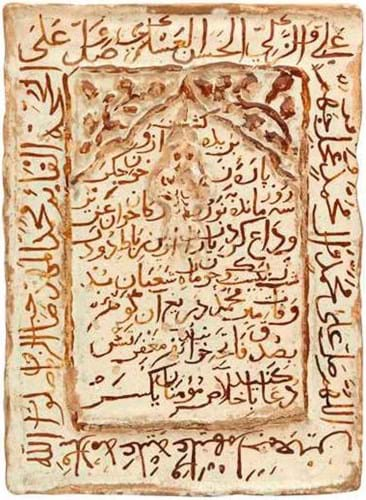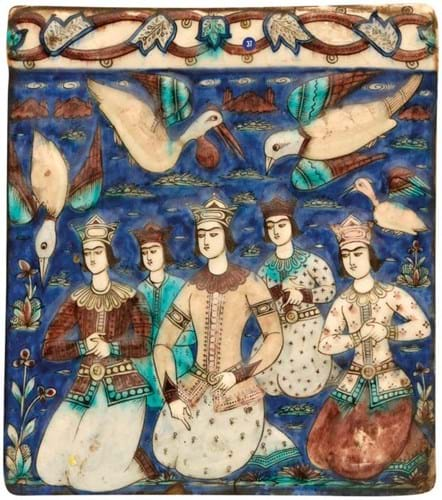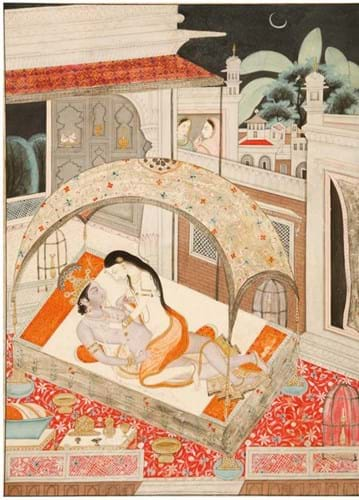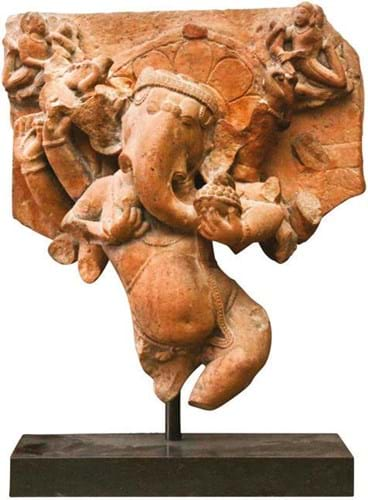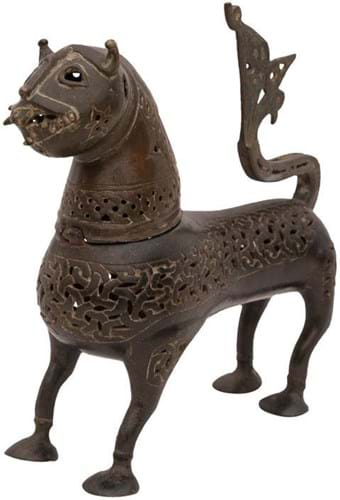
Lion form bronze incense burner made in eastern Iran or Afghanistan in the 11th or 12th century – £9000 at Chiswick Auctions.
A private single-owner collection offered on October 28 focusing on the arts of Iran was offered in the morning session. It was the fourth tranche of this assemblage offered and all of the 89 lots found buyers – the second ‘white glove’ sale in Beatrice Campi’s career since she founded the department in 2018.
Some fine pieces of metalwork were led by a 9in (22cm) incense burner in the form of a lion made in eastern Iran or Afghanistan in the 11th or 12th century.
Such zoomorphic openwork bronze incense burners are perhaps the best-known metalwork creations of the Seljuk period in Iran although only a handful of complete period examples are known. They would doubtless command six-figure sums.
This example had cost a small fortune when sold in France a generation ago, but it is now understood to be a composite. While the body is period, the head and neck are a later addition.
However, this was amply reflected in the guide of £3000-5000 and it sold for £9000.
Written word
The importance of the written word in Islamic culture is often embodied in the sumptuous writing implements made for calligraphers.
A large Seljuk silver and copper-inlaid bronze inkwell made in the 12th or 13th century is a particularly good example of a type that comes for sale with relative frequency and perhaps a royal commission. The decorative scheme includes the signs of the Zodiac, roundels with courtly subjects and three inscriptions from the maker reading Amal-e al-Naqqash al-Khademin Amal-e Zaki – translated as ‘the work of the courtly painter, Zaki Bani or Raki Bani’.
The estimate was an affordable £800-1200 and it sold at £4200.
A moulded Timurid funerary tile with copper lustre decoration, probably made in Kashan in the late 15th or early 16th century, sheds light on a complex chapter of Iranian history which follows the Mongol invasion.
Production of the lustre wares which had flourished in Iran from the 12th to the 14th centuries had slowly resumed and kilns were rebuilt. Funerary tiles of the Timurid period are often inscribed with Persian verses commemorating the deceased, and in this case, provide factual details such as the name of the deceased (Mir Muhammad) and date of their death (three days before Nouruz).
Once part of the well-known collection of Arthur Sackler (1913-87), and a published piece, it fetched £3000.
More numerous – and less academic – are the 19th century polychrome-painted pottery tiles produced in Tehran, Isfahan and Shiraz during the Qajar period. These have waxed and waned in the market across the past two decades but those with unusual subject matter remain highly desirable.
The finely painted example here in cobalt blue, manganese purple, and turquoise with five princely figures kneeling in a landscape below four outsize birds was estimated at £800- 1200 and it sold at £4200.
Qajar on the rise
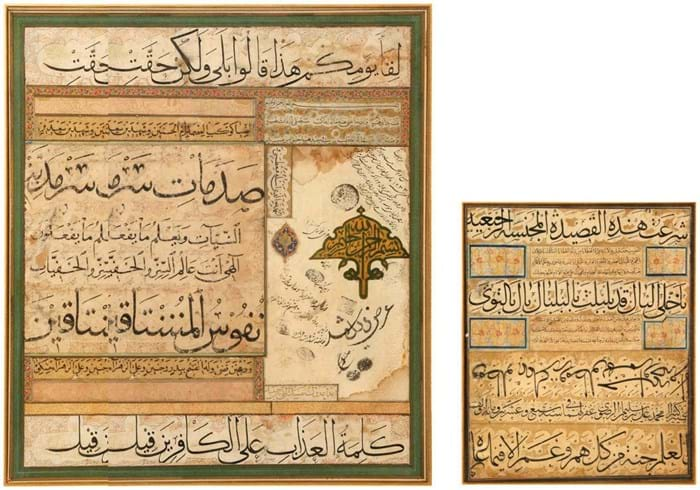
Two composite Muraqqa album pages with examples of the ’Six Scripts’ of Arabic calligraphy – £7000 at Chiswick Auctions.
Qajar period arts, once dismissed as lacking academic rigour by Western collectors and unpopular in Iran after the revolution, were largely unfashionable when this collection was formed from the 1980s. Today, however, they are currently riding a wave of reappraisal and appreciation.
“The market can now receive them with the same enthusiasms with which they were collected,” commented Campi.
The calligraphic highlight of this collection, which fetched £7000, were two composite Qajar muraqqa album pages with examples of the ‘Six Scripts’ of Arabic calligraphy.
These ‘cut and paste’ albums made up of admired examples of historic calligraphy and illumination were popular from the 16th century onwards: these specific examples include verses, prayers and qasida from the 15th to the 19th century, testifying to the endurance and success of this art form through the ages.
The final tranche of this collection will be offered in April.
Calligraphy creations

Folio from a 9th-10th century Qur’an written in north Africa or the western Islamic world – £7000 at Chiswick Auctions.
The mixed-owner afternoon sale comprised objects from the vast geographic extent of the Islamic and Indian lands, including a group of 1000-year-old Qur’an vellum folios from the early years of Islam.
Together they show the evolution of calligraphy from the mature Kufic Abbasid style to the hybrid form of the so-called New Script, laying the ground for the development of the modern script in use today.
One of the earliest folios in the group was from a manuscript on vellum written in north Africa or the western Islamic world as early as the 9th-10th century.
The style of most of these Kufic folios tended to be strikingly simple with each folio containing just a few lines of text. The focus was simply on the written word and the austerity and beauty of the Kufic script itself, with discreet verse markers in green or gold and red dots for the vocalisation as the only embellishment.
Here the 14 lines of text from the Sura al-Anbiya stand out for the elegant use of mashq or keshide (extensions of the horizontal letters) that is used for aesthetic effect. Probably penned at one of the wealthiest Fatimid or Spanish Umayyad courts, it got away at the top estimate of £7000.
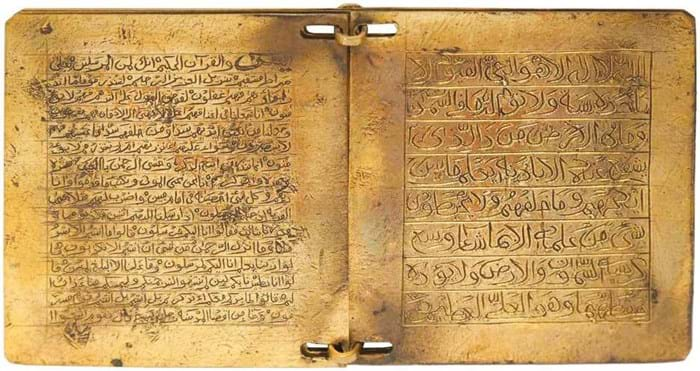
Indian 19th century miniature brass book engraved with verses from the Qur’an – £5000 at Chiswick Auctions.
There was a full five minutes of bidding from £200 up to £5000 for a miniature brass book and case, a personal devotional object produced in India in the 19th century.
Engraved in Arabic across five flat sheets of brass, each just 3½ x 3in (9 x 7cm), are the key verses from the Qur’an – the al-Fatiha susa, the Yasin, the Throne Verse – and charts containing the names of Allah. It was incomplete but at least two bidders were aware of its significance, and perhaps the patron for which it was made.
Among a strong selection of Indian paintings was an illustration from a Rasika Priya series, the epic story of love, longing and regret, painted in Mandi c.1810-20. The scene of Radha and Krishna in an intimate embrace on a moonlit terrace is attributable to influential Guler court painter Sajnu.
This illustration, bursting with lively incidental detail (two women look down on the couple and gossip) was purchased from the private collection of Francisco Garcia in New York and came for sale from a US collection. It had a guide of £4000-6000 and brought £10,000.
The auction house referenced a similar folio attributed to Sajnu sold at Sotheby’s New York in 2016 for $42,000.
Ganesha sculpture
A fine example of north Indian medieval sandstone sculpture depicting the Hindu elephant-headed god Ganesha took £12,000. The sculpture – that found plenty of admirers when displayed in the window of Chiswick’s new saleroom – was possibly once part of a stele or architectural niche carved in the 12th or 13th century Mathura.
It shows the bejewelled ‘Remover of Obstacles’ standing with a floral medallion as halo, six of his arms and hands still intact. Provenance is important in this market and this piece was understood to have been purchased by the uncle of the vendor at Spink in the 1970s. An old inventory sticker reads The Roland- Geist Collection, Gift of George Roland.
It had previously gone unsold with a reserve of £7000 at a saleroom on the south coast of England but here sold to a European collector of Hindu sculpture well above estimate.

Pair of navratna gem-encrusted gold and champleve enamel arm bracelets – £4500 at Chiswick Auctions.
The Indian lot used by Chiswick Auctions as its main promotional image during Asian Art in London was a pair of gem-encrusted gold and champleve enamel arm bracelets (bazubands). Expected to bring £5000-7000, they sold at £4500.
The nine gemstones featured (ruby, pearl, coral, garnet, blue sapphire, cat’s eye, yellow topaz, emerald and diamond) are the socalled navratna gems that represent the nine celestial bodies of Hindu astrology. Carefully arranged to follow cosmological rules, each panel is centred by a ruby: the gem of the solar deity Surya.
A favourite adornment of the Mughal court, this pair was made in Jaipur in the first half of the 19th century and has survived in excellent condition.


